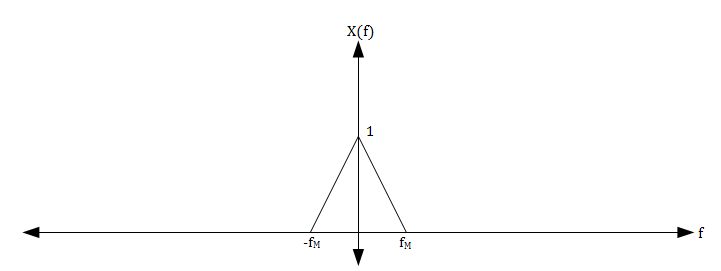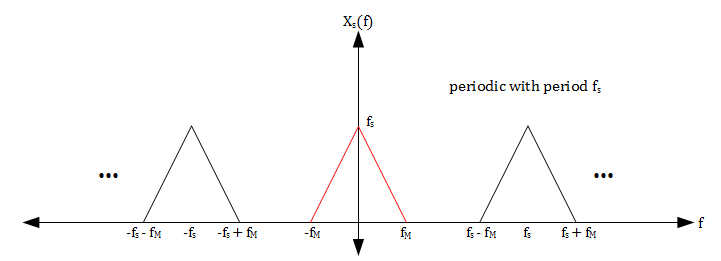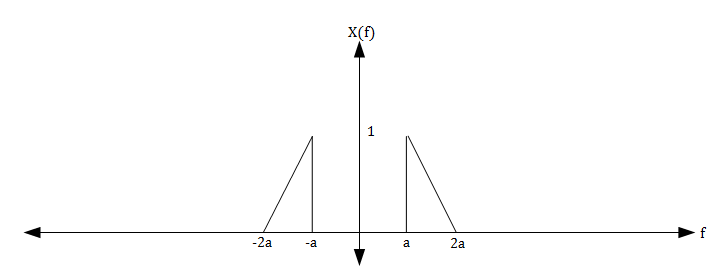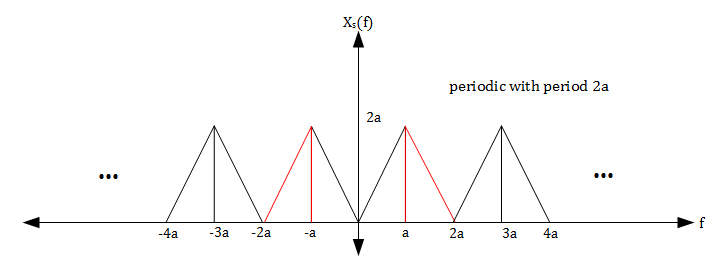Nyquist Theorem, with proof and example
A slecture by ECE student Miguel Rodrigo Castellanos
Partly based on the ECE438 Fall 2014 lecture material of Prof. Mireille Boutin.
Outline
- Introduction
- Proof
- Example
- Conclusion
Introduction
The Nyquist theorem provides a sufficient condition for perfect reconstruction of a signal from its sampling. In this slecture I will give a proof of the Nyquist theorem and give an example demonstrating how perfect reconstruction is possible even when violating the Nyquist condition.
Proof
Nyquist Theorem: A signal $ x(t) $ that has the property $ X(f) = 0 $ for $ |f| \ge f_M $ can be perfectly reconstructed from its sampling $ x_s(t) $ if sampled at a rate $ f_s > 2f_M $.
Let $ x_s(t) = x(t)p(t) $ be the ideal sampling of $ x(t) $, where $ p_{\frac{1}{f_s}}(t) = \sum_{k = -\infty}^\infty \delta(t-\frac{k}{f_s}) $.
To prove that perfect reconstruction is possible, we must find an expression for $ x(t) $ in terms of $ x_s(t) $.
Given that $ \mathcal{F}(x(t)) = X(f) $, we can find $ X_s(f) $ using the convolution property.
$ \begin{align} X_s(f) &= X(f)*\mathcal{F}(p_{\frac{1}{f_s}})\\ &= X(f)*\mathcal{F}(\sum_{k = -\infty}^\infty \delta(t-\frac{k}{f_s}))\\ &= X(f)*f_s\sum_{k = -\infty}^\infty \delta(f-kf_s)\\ &= f_s\sum_{k = -\infty}^\infty X(f)*\delta(t-\frac{k}{f_s})\\ &= f_s\sum_{k = -\infty}^\infty X(f-kf_s)\\ \end{align} $
Consider the signal $ x(t) $ has the spectrum shown in the figure below.
We would like to determine what $ X_s(f) $ looks like in order to find a way to reconstruct $ x(t) $.
Since we have sampled at a rate $ f_s > 2f_M $, the following inequalities hold:
$ f_s > 2f_M \iff f_s - f_M > f_M \iff -f_s + f_M < f_M $.
Combining these inequalities with the graph of $ X(f) $ and the expression for $ X_s(f) $ in terms of $ X(f) $ imply that $ X_s(f) $ will have the spectrum shown in the figure below.
Notice that the spectrum of the ideal sampling of a signal is an amplitude scaled periodic repetition of the original spectrum. Since $ x(t) $ is bandlimited and we have sampled at a rate greater than twice the bandwidth, the periodic repetitions of $ X(f) $ do not overlap.
In addition, all the information needed to reconstruct $ X(f) $ can be found in the portion of $ X_s(f) $ that corresponds to $ X(F) $ (shown in red). Therefore we can use a simple lowpass filter with gain $ \tfrac{1}{f_s} $ and cutoff frequency $ \tfrac{f_s}{2} $ to recover $ X(f) $ from $ X_s(f) $.
$ X(f) = X_s(f)\left\{ \begin{array}{ll} \frac{1}{f_s}, & |f| \le \frac{f_s}{2}\\ 0, & \text{else} \end{array} \right. $
$ \iff x(t) = x_s(t)*sinc(f_st) $
$ \therefore $ We can perfectly reconstruct $ x(t) $ from $ x_s(t) $.
Example
Though the Nyquist theorem states that perfect reconstruction is possible if sampling at a rate greater than twice the bandwidth, it is important to note that this condition is not necessary. The following example demonstrates how perfect reconstruction is sometimes possible even when undersampling.
Let the signal $ x(t) $ have a spectrum $ X(f) $ as seen in the figure below.
The Nyquist condition states that we should sample at a rate $ f_s > 2(2a) = 4a $. Instead, let us sample at $ f_s = 2a $.
As before, we have $ x_s(t) = x(t)p_{\frac{1}{f_s}}(t) \text{ and } X_s(f) = f_s\sum_{k = -\infty}^\infty X(f-kf_s) $
$ \implies X_s(f) = 2a\sum_{k = -\infty}^\infty X(f-2ka) $.
Therefore, $ X_s(f) $ will have the spectrum shown in the figure below.
Notice that although we have undersampled, there is no aliasing in the frequency domain, and the portion of $ X_s(f) $ that corresponds to $ X(f) $ (shown in red) can be recovered using a bandpass filter with gain $ \tfrac{1}{2a} $ and cutoff frequencies $ a \text{ and } 2a $.
Conclusion
To summarize, the Nyquist theorem states that any bandlimited signal can be perfectly reconstruction from its sampling if sampled at a rate greater than twice the bandwidth. However, the Nyquist condition is not necessary for perfect reconstruction as shown in the example above.
(create a question page and put a link below-- Use question page template)
Questions and comments
If you have any questions, comments, etc. please post them on this page.





